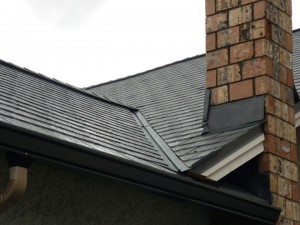When Should You Replace Roof Flashings?
September 21st, 2022Your roof is a major structural component of your home (or any building for that matter), and one that requires regular maintenance and repairs in order to preserve optimal functioning. With respect to shingled roofs, shingle replacement is a common repair. Sometimes you’ll replace an entire roof, while other times you’ll need only to conduct repairs to a portion of your roof. Because roofing repairs and/or replacements constitute a sizeable investment, you want to take every precaution to prevent major repairs. So, let’s turn our attention to flashing and the integral role it plays in protecting your roof.
What is Flashing?
First, let’s get a better understanding of flashing. Simply put, flashing serves one major purpose, and one purpose only: flashing prevents water from entering wherever there are penetrations on your roof. Examples of roof penetrations include vents, chimneys, pipes, and drains.
Flashing is a relatively inexpensive roofing material, and many professionals will replace flashing whenever shingle damage is near or incorporates flashing. That being said, it isn’t always necessary to replace flashing when conducting shingle repairs or replacements. In fact, depending on the type of flashing, you may or may not need to replace it. Let’s have a closer look.
Drip Edge Flashing
Generally speaking, there are two varieties of drip edge flashing. One type of drip edge flashing is designed to protect the gutter edge of your roof and the other to protect the edge or roof rake edge of your roof. Drip edge flashing channels water off the roof and away from the fascia, and it is attached to the roof before roofing felt is applied. Most roofing professionals advise replacing drip edge flashing unless the current flashing is in new condition.
Gutter Flashing
Roofers will also recommend replacing gutter flashing when shingle repairs or replacement is already being done. However, if you have decorative attachments that are attached to gutter flashing using screws or spikes, you should consider overlaying your drip edge with new gutter flashing.
Penetration Flashing
Heating, ventilation, and air conditioning penetrations, pluming vent pipes, and other roofing penetrations usually feature metal or rubber flashing that serves to seal penetrations and prevent water from entering your home. Ideally, you want to replace all rubber boots during your roofing repairs. Metal flashing should be replaced unless it is in new condition.
Valley Flashing
As the name suggests, valley flashing is installed whenever two roof planes intersect in order to direct water flow. Valley flashing should always be replaced as the demands on this type of flashing can be significant.
Vertical Wall Flashing
Similar to valley flashing, vertical wall flashing is installed when one roofing plan meets a wall such as a chimney, dormer, or even a split-level roof. It can be difficult to remove and replace this flashing, particularly when the flashing has been grouted at the joints. Nevertheless, unless this flashing appears in new condition, you should replace it.
Food For Thought
As you can see, it is almost always beneficial to replace flashing when you are conducting roof repairs. That being said, this kind of work is always best left to roofing professionals who can more accurately assess the quality and durability of all your roofing structures and materials.





